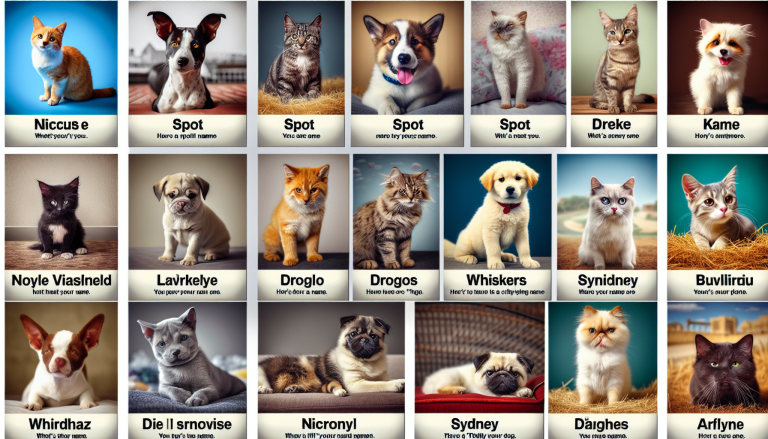Losing a beloved pet can be a distressing experience, but fear not, for we have compiled 10 essential tips to help you find your furry friend. From spreading the word in your community to utilizing social media and enlisting the help of local shelters, these practical and compassionate strategies will increase your chances of a swift reunion with your lost pet. So, take a deep breath, stay positive, and let’s embark on this journey together to bring your furry companion back home.
Table of Contents
ToggleMake a plan
When you realize your beloved pet is missing, it’s important to have a clear plan in place to increase your chances of finding them quickly and safely.
Create a search area
First, establish a search area where you believe your pet may have gone missing. This could be your neighborhood, nearby parks, or any places they usually enjoy exploring. By narrowing down the search area, you can focus your efforts more effectively.
Organize a search team
Enlist the help of family, friends, and neighbors to form a search team. More pairs of eyes will greatly increase the chances of finding your lost pet. Assign specific areas to each team member, and communicate regularly to share information and update on any progress.
Post lost pet signs
Creating and posting lost pet signs is a tried-and-true method of spreading the word about your missing pet. Include a clear, recent photo of your pet, along with your contact information and a brief description. Hang these signs in highly visible locations, such as street corners, community bulletin boards, and local businesses.
Utilize social media
Harness the power of social media by creating posts about your lost pet and sharing them with your online community. Include relevant details, such as the date and location your pet went missing, their physical description, and any distinct markings or features. Encourage others to share your posts to reach a wider audience.
Contact local shelters and animal control
Getting in touch with local shelters and animal control agencies is crucial when searching for a lost pet.
Call and visit nearby shelters
Contact all the shelters in your area and provide them with a detailed description of your pet. If possible, visit the shelters in person to check if your pet has been brought in. Keep in mind that shelters have different policies regarding how long they hold animals, so it’s important to start this process as soon as possible.
Provide detailed information
When contacting shelters, be prepared to provide specific information about your pet, such as their name, breed, age, sex, distinctive markings, and any relevant medical or behavioral details. The more information you can provide, the easier it will be for the shelter staff to identify your pet if they come across them.
Check with animal control
Reach out to your local animal control agency, as they might have information about any pets they have picked up or received reports about. Provide them with a comprehensive description of your pet and ask if they have any relevant information. Remember to follow up with them regularly in case new information becomes available.
Alert neighbors and community
Your immediate neighbors and the local community can play a crucial role in helping to find your lost pet.
Inform immediate neighbors
Let your neighbors know about your missing pet by personally visiting them or leaving a note explaining the situation. Provide them with a flyer or picture of your pet and ask them to keep an eye out for them. Neighbors can often be your eyes and ears, especially if they spend a lot of time outside or have seen anything unusual.
Distribute flyers in the neighborhood
Create eye-catching flyers with a clear photo of your pet, your contact information, and details about when and where they went missing. Distribute these flyers in your neighborhood, at nearby parks, and around local shops. Consider offering a reward as an incentive for anyone who finds and returns your pet.
Contact local businesses and schools
Expand your outreach efforts by reaching out to local businesses, schools, and community centers. Many of these places have bulletin boards where you can hang flyers or leave copies of your contact information. By involving the broader community, you increase your chances of finding your pet through word of mouth.
Utilize online resources
In today’s digital age, utilizing online resources is an effective way to increase the visibility of your lost pet.
Use online lost pet directories
Numerous websites and organizations specialize in reuniting lost pets with their owners. Register your pet’s information on these platforms, including a detailed description and a recent photo. Some directories even allow you to set up alerts so that you can be notified if someone finds a pet matching your description.
Post on online community forums
Join local online forums, message boards, and social media groups dedicated to lost and found pets. Share the details of your missing pet, along with pictures, and ask the community for help in locating them. Online communities are often supportive and can provide valuable information and resources.
Search local classified ads
Regularly check local classified ads, both online and in print, for any found pet listings. People who find lost pets may post ads in search of the owners, so make sure you scan these listings frequently. Be proactive and reach out to anyone who may have found a pet matching your pet’s description.
Search during optimal times
To maximize your chances of locating your lost pet, it’s important to search during specific times.
Search during quiet hours
During the quieter hours of the day, when there is less noise and traffic, venture out to search for your pet. Early morning or late evening is often a good time, as there tend to be fewer people around. Avoid peak traffic and try to focus on areas where your pet might feel safe and comfortable.
Look for your pet at night
Many pets feel more comfortable and secure under the cover of darkness. Take a flashlight and carefully search your neighborhood, paying close attention to hiding spots, bushes, and under parked cars. Be sure to inform local law enforcement if you are searching at night to avoid any misunderstandings.
Be persistent
Don’t give up or lose hope if you don’t find your pet right away. Persistence is key when searching for a lost pet. Continue to search regularly, distribute updated flyers, and reach out to local resources. Your determination and perseverance can make all the difference in being reunited with your beloved pet.
Follow up on sightings
If you receive any information or sightings of your lost pet, it is crucial to follow up on them promptly.
Immediately investigate any sightings
Act quickly on any leads or sightings provided by community members or online platforms. Visit the location as soon as possible and carefully search the area. Bring along a recent photo of your pet to show to witnesses or anyone who might have seen them.
Ask for help from witnesses
If you come across a potential witness who claims to have seen your pet, ask them for as much detail as possible. Inquire about the time, location, and any distinguishing features they noticed. Their information can help you narrow down the search area and increase your chances of finding your pet.
Leave food and familiar items at the location
If there is a specific area where your pet has been sighted repeatedly, consider leaving some food or familiar items, such as a blanket or toy, at that location. This may entice your pet to return to a familiar scent or comfort. Use caution when leaving food, as it may also attract other animals.
Utilize scent-based strategies
Animals have a strong sense of smell, and utilizing scent-based strategies can be effective in finding a lost pet.
Leave a familiar scent outside your home
Place items with your pet’s familiar scent, such as their bedding or a piece of clothing with your scent, outside your home. The familiar smell may help guide your pet back if they are in the vicinity but disoriented.
Use your pet’s favorite treats or toys
Carry your pet’s favorite treats or toys with you during your search. Shake or squeak them periodically to attract their attention and encourage them to come out of hiding. Familiar sounds and smells can sometimes coax a lost pet to reveal themselves.
Consider employing professional scent tracking services
If your search efforts prove unsuccessful or you are unable to continue searching due to various reasons, consider hiring a professional scent tracking service. These trained dogs or handlers specialize in tracking lost pets and can significantly enhance your chances of locating your furry friend.
Consider offering a reward
Offering a reward can incentivize people to actively search for your lost pet and increase the likelihood of them being found.
Determine a suitable reward amount
Decide on a reward amount that you are comfortable offering. Consider the value of your pet and what you can afford. The reward should be enough to motivate people to actively search and report any sightings but not excessively high that it attracts false claims.
Advertise the reward
Incorporate the reward information on your lost pet signs, online posts, and flyers. Highlight that a reward is being offered and emphasize the importance of finding your pet. This can generate more attention and encourage people to be vigilant in their search efforts.
Coordinate with local animal shelters
Inform local animal shelters about the reward you are offering, as they can help spread the word among their staff, volunteers, and the community. Shelters often have contact with people who may come across stray animals, increasing the chances of someone noticing your lost pet.
Don’t panic, stay positive
While it’s natural to feel distress and worry when your pet is missing, it’s important to remain calm and maintain a positive outlook.
Stay calm and focused
Panicking can cloud your judgment and hinder your ability to think clearly. Take deep breaths, stay focused on the task at hand, and tackle the search process systematically. Remaining calm will help you make better decisions and increase your chances of finding your pet.
Keep hope and a positive attitude
Maintain a positive attitude throughout the search, even when the situation feels challenging. Remember that pets have been reunited with their owners after days, weeks, and sometimes even months. Your optimism and belief in being reunited with your furry companion will keep you motivated during the search.
Take care of yourself
Searching for a lost pet can be emotionally draining, so it’s important to take care of yourself as well. Get enough rest, eat well, and lean on your support network for emotional support. By taking care of your own well-being, you’ll be better equipped to continue the search for your pet.
Prevent future incidents
Once your lost pet is found and safely back home, take steps to prevent similar incidents from happening in the future.
Secure your home and yard
Identify and address any potential escape routes from your home and yard. Check your fences, gates, and doors for any gaps or vulnerabilities. Ensure that your pet cannot access hazardous areas and consider installing pet-proof locks or safety measures if necessary.
Update identification tags and microchips
Ensure your pet’s identification tags and microchip information are up to date. If your pet is lost and someone finds them, these identification methods will be crucial in quickly reuniting you with your pet. Make sure your contact information, including phone number and address, is accurate and easily visible.
Consider GPS trackers for pets
Invest in a GPS tracker designed specifically for pets. These devices can be attached to your pet’s collar and provide real-time location updates. With a GPS tracker, you can quickly locate your pet if they go missing again, giving you peace of mind and allowing for swift action.
Remember, finding a lost pet can be a challenging and emotionally draining experience, but with a well-structured plan, persistence, and the support of your community, the chances of being reunited with your beloved pet significantly increase. Stay positive, stay proactive, and never give up hope.








